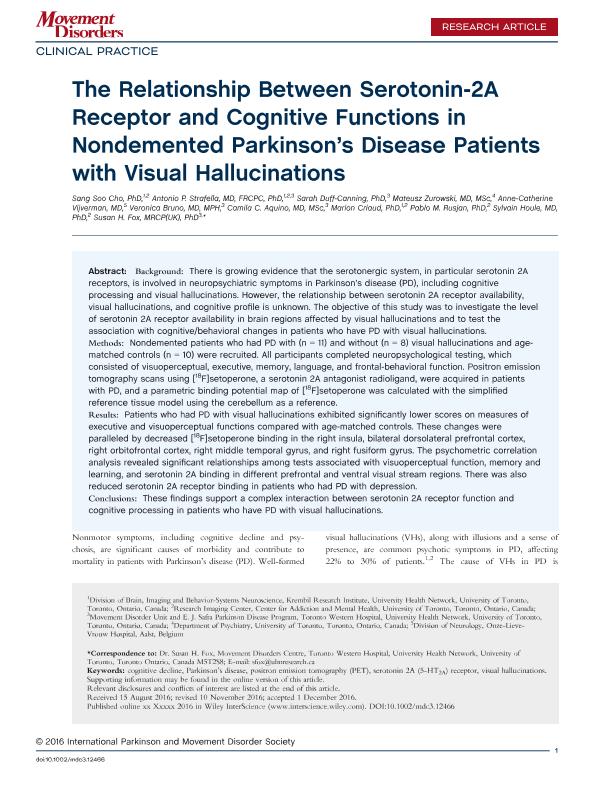Artículo
The Relationship Between Serotonin-2A Receptor and Cognitive Functions in Nondemented Parkinson's Disease Patients with Visual Hallucinations
Cho, Sang Soo; Strafella, Antonio P.; Duff Canning, Sarah; Zurowski, Mateusz; Vijverman, Anne Catherine; Bruno, Veronica Andrea ; Aquino, Camila C.; Criaud, Marion; Rusjan, Pablo M.; Houle, Sylvain; Fox, Susan H.
; Aquino, Camila C.; Criaud, Marion; Rusjan, Pablo M.; Houle, Sylvain; Fox, Susan H.
 ; Aquino, Camila C.; Criaud, Marion; Rusjan, Pablo M.; Houle, Sylvain; Fox, Susan H.
; Aquino, Camila C.; Criaud, Marion; Rusjan, Pablo M.; Houle, Sylvain; Fox, Susan H.
Fecha de publicación:
09/2017
Editorial:
Wiley
Revista:
Movement Disorders Clinical Practice
ISSN:
2330-1619
Idioma:
Inglés
Tipo de recurso:
Artículo publicado
Clasificación temática:
Resumen
Background: There is growing evidence that the serotonergic system, in particular serotonin 2A receptors, is involved in neuropsychiatric symptoms in Parkinson's disease (PD), including cognitive processing and visual hallucinations. However, the relationship between serotonin 2A receptor availability, visual hallucinations, and cognitive profile is unknown. The objective of this study was to investigate the level of serotonin 2A receptor availability in brain regions affected by visual hallucinations and to test the association with cognitive/behavioral changes in patients who have PD with visual hallucinations.
Methods: Nondemented patients who had PD with (n = 11) and without (n = 8) visual hallucinations and age‐matched controls (n = 10) were recruited. All participants completed neuropsychological testing, which consisted of visuoperceptual, executive, memory, language, and frontal‐behavioral function. Positron emission tomography scans using [18F]setoperone, a serotonin 2A antagonist radioligand, were acquired in patients with PD, and a parametric binding potential map of [18F]setoperone was calculated with the simplified reference tissue model using the cerebellum as a reference.
Results: Patients who had PD with visual hallucinations exhibited significantly lower scores on measures of executive and visuoperceptual functions compared with age‐matched controls. These changes were paralleled by decreased [18F]setoperone binding in the right insula, bilateral dorsolateral prefrontal cortex, right orbitofrontal cortex, right middle temporal gyrus, and right fusiform gyrus. The psychometric correlation analysis revealed significant relationships among tests associated with visuoperceptual function, memory and learning, and serotonin 2A binding in different prefrontal and ventral visual stream regions. There was also reduced serotonin 2A receptor binding in patients who had PD with depression.
Conclusions: These findings support a complex interaction between serotonin 2A receptor function and cognitive processing in patients who have PD with visual hallucinations.
Palabras clave:
Alucinaciones
,
Deterioro Cognitivo
,
Parkinson
Archivos asociados
Licencia
Identificadores
Colecciones
Articulos(SEDE CENTRAL)
Articulos de SEDE CENTRAL
Articulos de SEDE CENTRAL
Citación
Cho, Sang Soo; Strafella, Antonio P.; Duff Canning, Sarah; Zurowski, Mateusz; Vijverman, Anne Catherine; et al.; The Relationship Between Serotonin-2A Receptor and Cognitive Functions in Nondemented Parkinson's Disease Patients with Visual Hallucinations; Wiley; Movement Disorders Clinical Practice; 4; 5; 9-2017; 698-709
Compartir
Altmétricas



